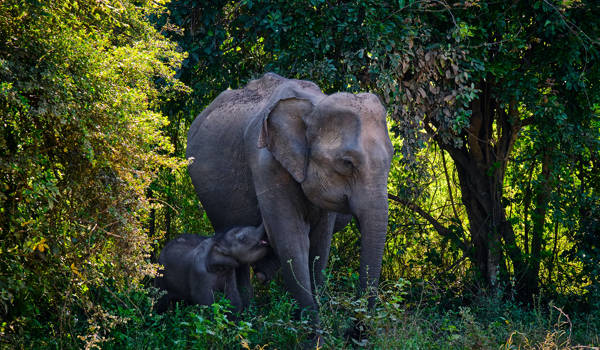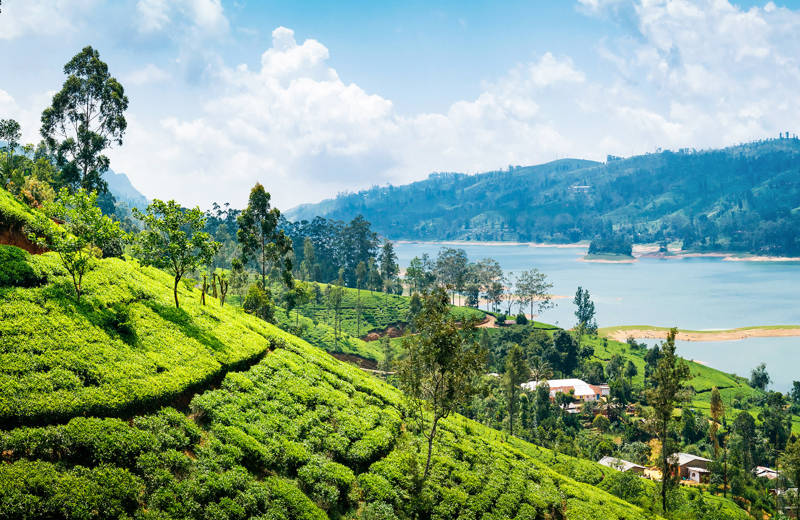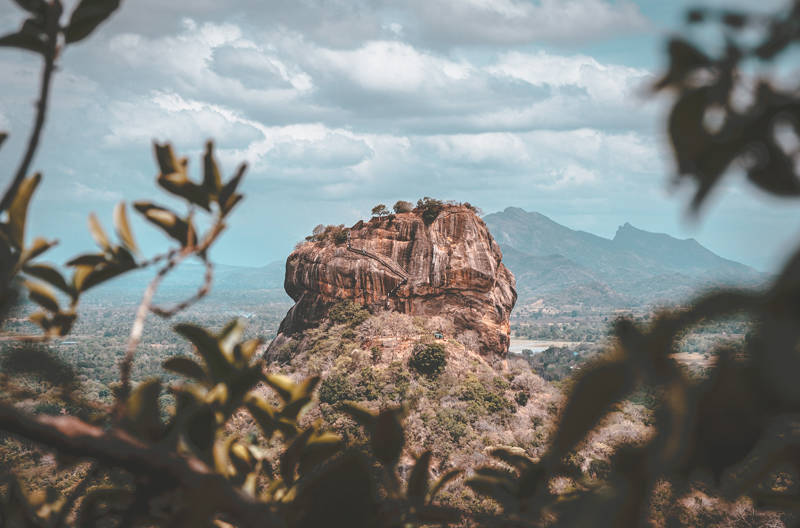Sri Lanka Seasons and Weather Guide
The best time to travel to Sri Lanka depends on which part of the country you want to visit. For sunny beaches on the west and south coasts, aim for December to March. If you’re heading to the east coast, April to September is ideal. This guide breaks down the best times to visit each region and what you can expect during your stay.

Trips to Sri Lanka
Sri Lanka is a favourite for many travellers, packed with a mix of adventures and experiences. Imagine exploring old temples, wandering through tea plantations, or spotting elephants in Udawalawe National Park.
Whether you're surfing on stunning beaches, hiking to crazy pretty viewpoints, or getting a taste of the local culture, Sri Lanka has something for everyone. You can enjoy delicious street food, visit bustling markets, and the train from Kandy to Ella, which is probably one of the most scenic ones in the world.
This island is perfect for those seeking authentic experiences off the beaten track. Ready for an unforgettable journey?
Key Takeaways
Sri Lanka’s climate is characterised by a tropical weather pattern with three distinct zones: dry, wet, and central highlands, and is influenced by two monsoon seasons.
The best time to visit Sri Lanka varies by region, with the west and south coasts, along with the central highlands, being ideal from December to March, and the north and east coasts best from April to September.
Sri Lanka offers year-round opportunities for beach activities and wildlife watching, with peak times for specific activities like whale watching (November to April) and elephant gatherings in Minneriya National Park (August and September).
Understanding Sri Lanka's Climate
The climate in Sri Lanka is characterised by warm, tropical weather that remains mostly stable throughout the year. The island can be divided into three distinct climate zones:
- The dry zone, located in the northern and eastern parts, experiences minimal rainfall and is known for its arid landscape.
- The wet zone, covering the south-western region, is lush and green due to frequent rainfall.
- The central highlands, with their cooler temperatures and misty mornings, offer a refreshing contrast to the humid lowlands.
In addition, Sri Lanka’s climate has got two monsoons. The southwest monsoon brings rain to the south and west from May to September, while the northeast monsoon affects the north and east from October to January. This dual monsoon system ensures that even when one part of the island is experiencing rain, another part enjoys sunny weather, making Sri Lanka a year-round destination for travellers.

Best Time to Visit Sri Lanka
The optimal time to visit Sri Lanka hinges on the specific region you intend to explore. The west and south coasts, along with the central highlands, are best visited from December to March. During this period, the weather is predominantly dry and sunny, making it ideal for beach holidays and exploring the hill country.
The peak tourist season in Sri Lanka spans from December to April, with January being particularly popular due to its excellent weather conditions. This period is perfect for enjoying the stunning beaches and trying your hand at surfing without the interference of rain. Additionally, the Adam’s Peak pilgrimage season, which runs from December to May, attracts many visitors to central Sri Lanka, making for a lively cultural experience.
If you've mainly got the north and east coasts on your itinerary, plan your visit between April and September. During these months, the weather is warm and dry, providing excellent conditions for beach activities and sightseeing. The period from May to October is especially good for visiting the east coast beaches, with their pretty tropical setting and clear skies.
Monsoon Seasons in Sri Lanka
The weather in Sri Lanka is strongly affected by its dual monsoon cycles. The southwest monsoon, known locally as Yala, affects the south and west regions from May to September. During this period, these areas experience heavy rainfall, resulting in lush greenery but also making it less ideal for beach activities and hiking. However, the eastern and northern parts of the island remain relatively dry and sunny, offering a great alternative.
The north east monsoon, or Maha, brings rain to the northern and eastern regions from October to January, marking the rainy season. This monsoon season is characterized by heavy rains, particularly in November and December, which can locally lead to unpredictable weather patterns. Despite this, the southern and western regions begin to dry up, making late November to April still a good time to visit these areas.
Between these two monsoons, Sri Lanka experiences shorter inter-monsoonal periods, primarily in October and November. These transitional phases can bring heavy rain and thunderstorms across the island, but they also mark the beginning of the dry season in the south and west, paving the way for the peak travel season. Understanding these monsoon patterns is necessary for planning your trip and getting the best weather conditions during your stay in Sri Lanka.

Festivals and Cultural Events
Sri Lanka's cultural heritage, honoring a varied blend of Buddhism, Hinduism, Islam, and Christianity, comes to life through its multitude of festivals and public holidays. These festivals offer a unique glimpse into the island’s traditions and are a highlight for many visitors. January ushers in the Duruthu Perehara, commemorating Buddha’s visit to Kelaniya with a grand procession at Kelaniya Raja Maha Viharaya Temple.
February’s Independence Day is celebrated nationwide with military parades, flag-hoisting ceremonies, and cultural performances. The Galle Literary Festival in late January is another major cultural event, attracting literary enthusiasts from around the world with over 70 activities, including panels, debates, and book launches.
April’s Sinhalese and Tamil New Year is a family-oriented festival involving the exchange of presents and preparation of traditional rice dishes, marking an important cultural moment. May’s Vesak Festival celebrates Buddha’s birth, enlightenment, and nirvana, with streets and homes adorned with colorful lanterns.
In July, the Kandy Esala Poya Perahera honors the sacred tooth relic of Buddha with a massive procession, including dancers, drummers, and decorated elephants. October or November features Deepavali, the Hindu Festival of Lights, symbolizing the triumph of good over evil. These festivals and cultural events add a vibrant touch to your travel experience in Sri Lanka.
Beach Weather in Sri Lanka
We love Sri Lanka’s beaches, if the weather works in our favour. The south coast gets its best beach weather from December to March, with hot and sunny conditions perfect for lounging and water activities like surfing. Not surprisingly, this is also the peak season in Sri Lanka, and the beaches can be more crowded than usual.
The west coast also gets excellent beach weather from January to April, with plenty of dry and sunny days. On the other hand, the east coast shines from May to September, with generally hot and dry weather, making it perfect for beach activities. Locations like Trincomalee, Pasikudah, and Arugam Bay are particularly nice to visit during this period, giving you lovely weather and calm seas for some of the best beach fun you'll ever get.
Wildlife Watching in Sri Lanka
Wildlife enthusiasts find Sri Lanka to be a haven, with loads of different species and great safari opportunities year-round. Whale watching is best from November to April, when the seas are a bit calmer, and you can spot blue whales and other species off the southern coast around Mirissa. Additionally, the gathering of over 200 elephants in Minneriya National Park during August and September is a spectacular sight if you happen to be in Sri Lanka during that time.
One of the best National Parks in Sri Lanka is Yala National Park, famous for its leopard sightings, which are especially frequent during the period from December to March. During this time you've got the best opportunity to catch a glimpse of these gorgeous big cats in their natural habitat. The dry season during these months increases the chances of seeing them, as they are more active these months.

Monthly Travel Guide
Understanding the monthly weather patterns and events can help you a lot with planning your Sri Lanka trip. The island’s climate varies significantly throughout the year, and knowing when to go can ensure you enjoy the best of what Sri Lanka has to offer. This monthly travel guide provides an overview of the weather conditions and key events, helping you decide the best time to visit.
Visiting Sri Lanka in January - March
From January to March, Sri Lanka is blessed with warm and dry weather. This is especially true for the central, western, and southern regions. The temperatures range from 22°C to 32°C, making it the perfect time for beach holidays and outdoor activities - but the high chance at great weather also makes it one of the busiest months.
February continues to offer beautiful weather with plenty of sunny days on the west and south coasts, and minimal rainfall. March is considered one of the best times to visit Sri Lanka, with the lovely weather continuing and reduced rainfall in the eastern parts making it a great time for a tropical getaway.
Visiting Sri Lanka in April - June
April marks the beginning of the southwest monsoon season, but it remains generally warm and dry across the majority of the country, with occasional thunderstorms. This is the perfect time to visit the beach as there are clear skies and long, sunny days, especially at the beginning of the month. The hill country of Sri Lanka is cooler during this period, averaging around 19°C, providing a fresh escape from the heat.
May sees the south west monsoon (Yala) bringing heavy rains to the southwest region, affecting the beach weather (and the tides!) on the south and west coasts. However, the east coast remains mostly sunny and dry, offering good conditions for beach holidays during the south west monsoon season. June continues to experience the southwest monsoon’s effects, but the eastern beaches remain a great option for travellers in search of sunny weather.
Visiting Sri Lanka in July - September
July to September is a fantastic time for beach holidays on the south coast, with minimal rain and warm temperatures. The hill country also experiences pleasant weather during this period, with cooler temperatures and occasional rain showers. This makes it an ideal time for exploring the simply stunning nature and enjoying outdoor activities in the central highlands.
In July, the effects of the southwestern monsoon are starting to get weaker, and the eastern coast beaches remain sunny and attractive. August sees a decrease in rain on the southern and western coasts, while the northern and eastern beaches continue to enjoy sunny weather. September marks the shoulder season, with eastern beaches still enjoying good weather but expected to see rain by the end of the month.
Visiting Sri Lanka in October - December
October to December marks the northeast monsoon season, affecting the north and east regions with heavy rains and thunderstorms. However, the south and west coasts start to dry up, making them more favorable for travel. October and November can still experience showers, but December typically brings hot and dry weather with occasional monsoon rains that usually calm down by the end of the month. This period is also rich in cultural festivities, adding vibrancy to your travel experience. The combination of mostly nice weather and cultural happenings makes it an exciting time to explore Sri Lanka, marking the start of the high season.

Summary
When planning a trip to Sri Lanka you need to take a look at the island’s diverse climate and cultural calendar. By understanding the best times to visit different regions, you can ensure that you get the best weather conditions and make the most of your trip. From basking in the sun on pristine beaches to spotting some of the island's incredible wildlife and joining in unique cultural festivals, Sri Lanka offers almost too many unforgettable experiences.
Whether you choose to visit during the dry season on the south and west coasts or explore the north and east during their sunny months, Sri Lanka’s year-round appeal ensures there’s always something spectacular to see and do. Embrace the island’s charm, plan your trip around the favourable weather and events, and let Sri Lanka’s enchanting beauty captivate you.
Frequently Asked Questions
When is the best time to visit Sri Lanka?
The best time to visit Sri Lanka is from December to March for the south and west coasts, as well as the central highlands, while the north and east coasts are ideal from April to September. Plan your visit accordingly to make the most of the weather and attractions.
What are the main monsoon seasons in Sri Lanka?
Sri Lanka experiences two main monsoons: the southwest monsoon from May to September, affecting the south and west, and the northeast monsoon from October to January, affecting the north and east.
When is the peak tourist season in Sri Lanka?
The peak tourist season in Sri Lanka is from December to April, especially on the south and west coasts, offering the best beach weather and ideal conditions for outdoor activities.
What are the best months for wildlife watching in Sri Lanka?
The best months for wildlife watching in Sri Lanka depends on the species. Whale watching is best from November to April, birdwatching from December to March, the elephant gathering in Minneriya National Park from August to September. And leopard spotting in Yala National Park from December to March.
What are some major cultural festivals in Sri Lanka?
Sri Lanka hosts several major cultural festivals such as the Duruthu Perehara, Independence Day, Sinhalese and Tamil New Year, Vesak Festival, and Kandy Esala Poya Perahera. These celebrations showcase the country's diverse cultural heritage and traditions.

